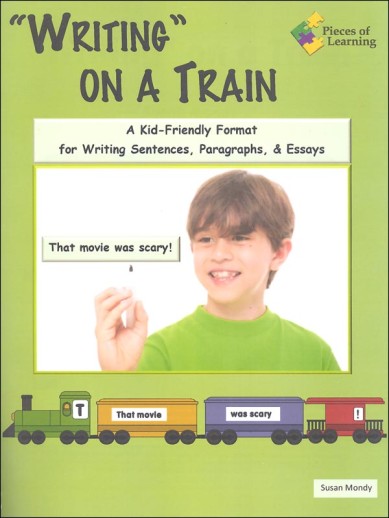We use cookies to make your experience better. To comply with the new e-Privacy directive, we need to ask for your consent to set the cookies. Learn more.
"Writing" on a Train
Now this is a great idea! There's nothing like a good graphic organizer to bring order to chaotic thinking and to illustrate the fact that anything even something as intimidating as writing can be taken one step at a time. Starting with a simple sentence and using a train analogy engine (capital letter), cars (one for subject; one for predicate), caboose (ending punctuation) the author illustrates how easy it is to teach children to understand the building blocks of good writing. Once the concept is learned and practiced with simple sentences and then compound sentences, other important elements can be drawn into the train analogy. For instance, the couplers are common sense (do these train parts go together and make sense). Taking a step-by-step approach and utilizing the train analogy at every "junction," coverage in basic writing components is comprehensive types of sentences, compound subjects and predicates; run-on sentences (i.e. a train wreck) and even journeys into the important territory of making sentences interesting (colorful words and interesting detail).
This is only the beginning, however. Using the same train analogy, it's just a short trip into developing paragraphs (engine focus/topic; first through fourth cars support sentences; caboose conclusion; couplers transition words) and going on from there to explore essays and reports. The author provides a straight-forward instructional path for you to utilize, as well as numerous reproducible train worksheets and masters. All necessary vocabulary (subject, predicate, coupler, exclamation, etc.) is provided in large print laminatable for classroom/schoolroom reminders.
All in all, this is a great introduction to writing and one that will be especially welcome for "concrete" kids and those needing clear, step-by-step instruction. 90 pgs, spiral-bound ~ Janice
Writing on a Train is a supplement to your grammar curriculum. The worksheets can be done together as a class integrated into your language classes. If your class moves from simple sentence structure to the four types of sentences, there are worksheets to tie the train idea into understanding declarative, interrogative, exclamatory, and imperative sentences. There also are worksheets to supplement teaching compound subjects, compound predicates, run-ons, and compound sentences. All use the train analogy. As you move to paragraph structure, you will find activities to do as a class that again link the paragraph to the simple train analogy. Students don't have to learn new writing ideas; they just expand on what they learned about sentences. The same is true if you move into simple essays. There is a helpful Thinking Page worksheet for students to use in planning their essay work.
Included are master sheets of train cars to use for bulletin boards or as name tags for the students. Just having a train car on the desk can help your students remember to make all their writing like a train.
These materials provide practice for developing individual skills necessary to writing rather than focusing on the work as a whole.
| Product Format: | Paperback |
|---|---|
| Brand: | Pieces of Learning |
| Author: | Susan Mondy |
| Grades: | 3-6 |
| ISBN: | 9781937113940 |
| Length in Inches: | 11 |
| Width in Inches: | 9 |
| Height in Inches: | 0.5 |
| Weight in Pounds: | 0.65 |

